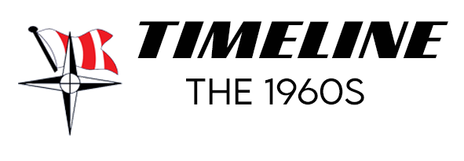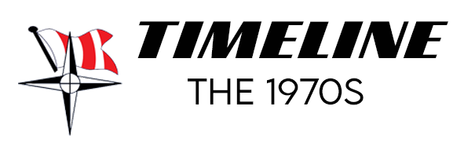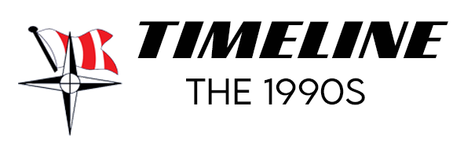1953
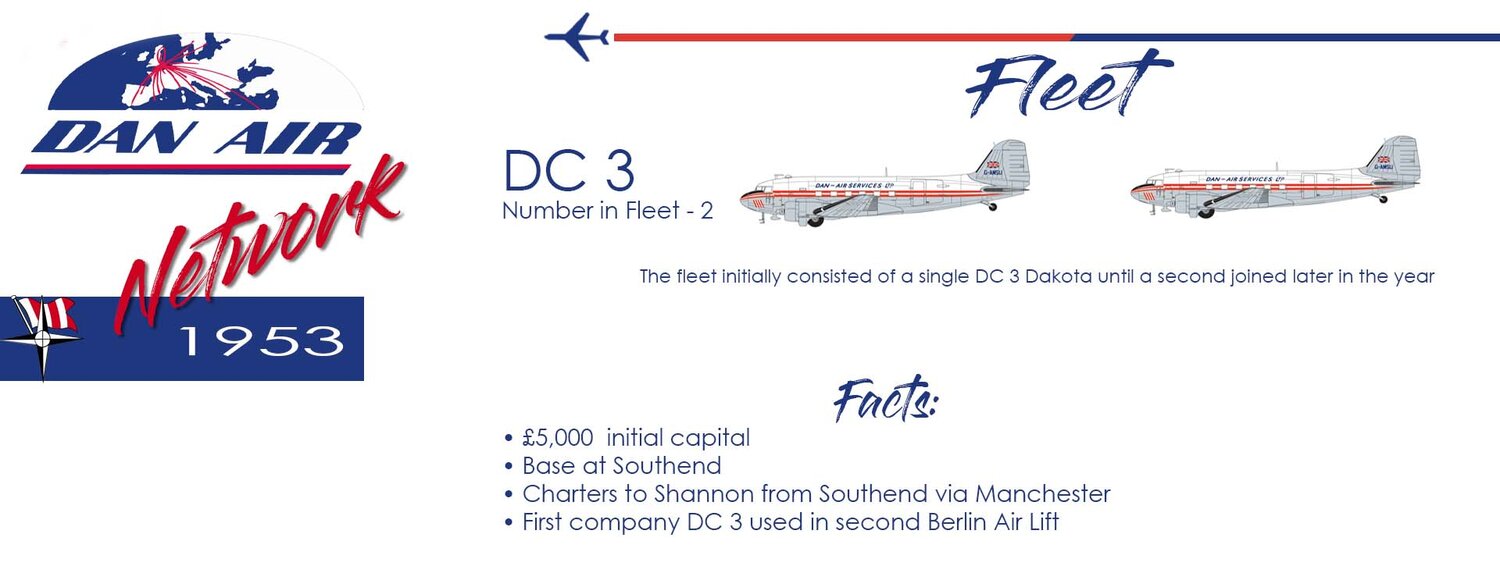

1954
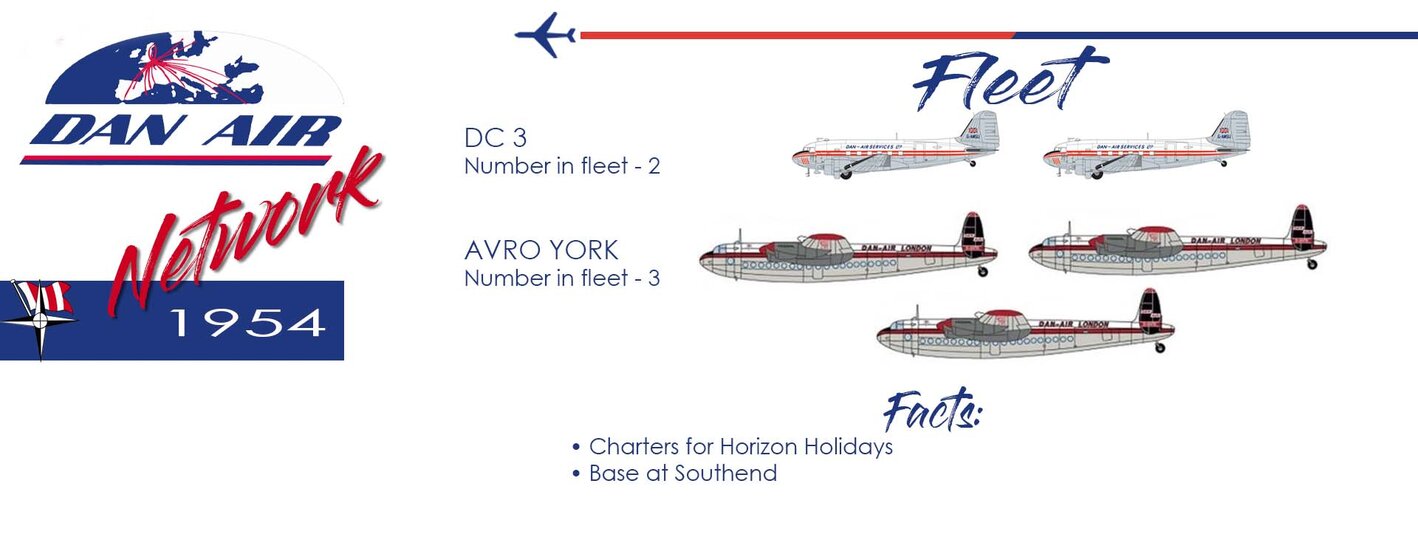
in 1954 three Avro Yorks were obtained and they were immediately put to work on cargo charter flights. No licences were awarded to Dan-Air to carry out scheduled services. The UK's air licencing board - The ATLB rigidly stood by the 'Provision One' rule giving UK independent airlines very limited scheduled licences. More that 95% of scheduled flights UK were operated by the two national carriers, BEA and BOAC. The independent airlines would try almost anything in an effort to encourage passengers to fly. Hunting Clan, one of the major independents tried 'air credit' under the scheme 'Go and pay' and 'Pay and go' - this would, as the name implies allow passengers to pay in instalments either before their trip or after they had taken it. Dan-Air objected to the scheme.
As the company had, in a way, come about by accident, the decision as to whether the airline should continue had to be taken. Davies and Newman Ltd decided to carry on with the airline. The company would need to have a longer term strategy in place to give it a marketable brand image. If it were to be a permanent feature it would need to expand. Several airlines had sprung up in the UK in the post-war years. There was an excess availability of DC3 aircraft that were no longer needed by the air force and many regular airmen had left the RAF as trained pilots. They had not been wealthy individuals who would be the pre-war passengers, but ordinary people, given an extraordinary opportunity to learn to fly. Many of the airlines had failed almost as quick as they had began. This high level of failure made the ATLB reluctant to award licences, so they said, to independent carriers, as the likelihood of passengers losing money having paid for tickets was high. This was still evident in 1954, nine years after the war ended. There were also concerns that some of the small airlines had cut corners with safety standards. Dan-Air would need to be different. Certainly Davies and Newman were not newcomers to industry, Mr. Frank Newman the Chairman of Davies and Newman had left £79,339 in his will (with £26,361 in duty). The company was in a position to provide financial backing, office space, and business acumen. Recruiting the right people had been important. A chief pilot, chief stewardess, an engineering base, and administration support had all been put in place. In fact, Lasham Airfield in near Basingstoke came complete with a newly re-surfaced runway and hangar space. The RAF had de-commissioned the airfield and agreed to lease it to Dan-Air for a twenty five year period. Unlike many of their contemporary airlines, Dan-Air had already proved to be an effective operator. It was not going to be easy to obtain licences for scheduled services, especially without access to London's main airport at Heathrow.
1955
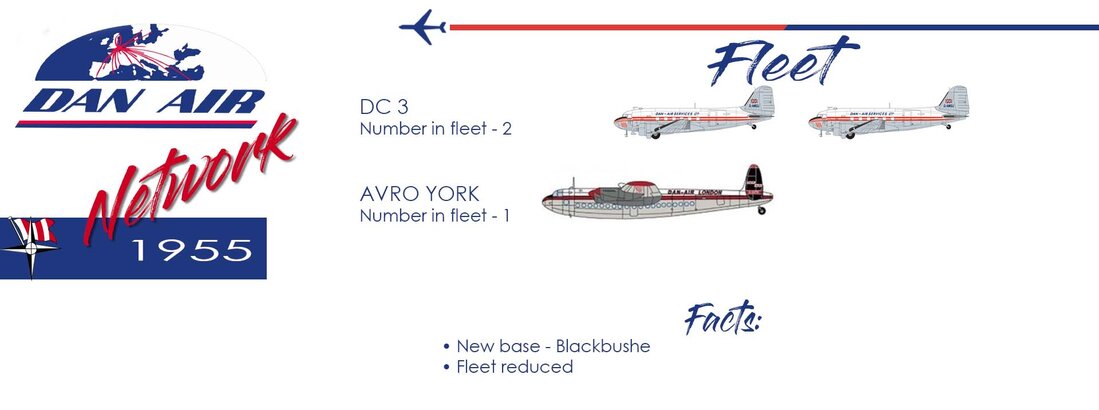
Trading for Dan-Air had been difficult in the first two years. Not all of the Avro York fleet been fully used and the decision was made to lease two of them to other carriers. The DC3 had proved to be effective as a passenger aircraft and would be in demand for the year with more flights operated on behalf of Horizon Holidays.
The Engineering division at Lasham were recruiting aircraft fitter and riggers for the DC3 and Avro York fleet. In particular the company wanted ex RAF Non Commissioned Officers! This was with an hourly pay of 4 shillings and 4 1/2 pence per hour! An ex WAAF typist/tech records clerk was also required. A caravan site was available to successful applicants to live in! That year a Deputy Chief Inspector was also sought.
Blackbushe airport became the airline's second base this year. The busy airport was used by many airlines including several American operators. BOAC commenced their Comet flights from Blackbushe and Dan-Air aircraft were among the 36,000 movements annually at the airport. The runway had a major problem, in as far as a major road ran across it. Motorists were not unaccustomed to having to wait until an airliner went past before continuing their drive.
The airline designed and applied a new, fleet-wise livery to all aircraft. That same year, the Ministry of Aviation granted Dan-Air permission to operate a limited programme of a new type of low-fare service that combined air travel and overseas holiday accommodation at a cost substantially below the aggregate of each individual component if purchased separately. Flights would be severely restricted and could not operate on routes where a schedued BEA or BOAC flight existed. These 'package trips' would go on to become the standard holiday for British travellers for the next half century. Dan-Air would not know just how important they would become to them, nor how big a player they would be in the industry. With this new system now available, UK independents all hurried to make their aircraft available to any would-be Tour Operators. British Eagle offered to be Thomas Cook's own in-house airline, an offer that was declined.
Dan-Air found themselves in all parts of the world carrying cargo on a charter basis. Passenger charters were still a long way from being established for average British citizens. Prices for scheduled flights were high and the desire to travel was low. For those adventurous enough, the Channel Islands were an obvious choice, as was the Isle Of Man. Thomas Cooks chartered Dan-Air's aircraft for these flights. The Dakota was ideal for short hops to such locations.
Dan-Air's own early ventures into these overseas package holidays was a low key affair when Horizon Holidays chartered their two Dakotas for a series of flights to Sardinia. The new holiday packages included accommodation in tents, all meals, drinks and return transfers between the overseas airport to the hotel. The flying time was lengthy; at more than five hours. It could sometimes be a bumpy ride on some flights as the aircraft flew at relatively low altitude and were susceptible to any bad weather. The DC 3 did not have a pressurised cabin. This could result in 'ear popping' during take and landing. The aircraft were also prone to technical issues, leading to long delays.
Mrs. Rose Parkinson, born in 1929, got in touch via her daughter and told us;
'I was born in Ilford and was working as a bus conductress. I married when I was twenty five. My husband had a good job and had been saving for a long time to get us on an overseas honeymoon. I had no idea that it had been planned. He even got me to have a passport photo taken, saying it was so he could keep a picture of me in his wallet. You could travel on the same passport as your husband back then. So he told me a day before the wedding that where we were going to Majorca, and I swear to you, I thought he said 'Morecambe'. Eventually, I understood, but had no idea where Majorca was! After the wedding we stayed at his parents overnight. I was terrified and excited in equal parts. So the next day we set off to Blackbushe, we had to be there at 7am for the 8am departure. I was almost sick with nerves. When I saw all the aeroplanes I was sure I wouldn't get on one. My husband was very good with me. Everyone was so dressed up, I had my going away suit on - in 100% wool - with a hat! I think the flight had a bit of a delay, which only made me more nervous. Eventually we were escorted to this aircraft, which was a DC3. It seemed enormous, I know today's planes are a lot bigger, the woman who took us out must have sensed my nerves and reassured me. I had thought she was coming with us and asked her to sit near me! There was a lovely young hostess who did look after everyone. We were basically told to sit forward and strap in. Oh it was bumpy on the runway, but once it got up in the air it was lovely. The hostess came with a meal - a sandwich and a pork pie I think. We had a cup of tea and biscuits and later on she came with another cup of tea and a slice of cake. We left Blackbushe at 9ish and landed in Majorca at 3pm, which was an hour in front of UK time. I couldn't believe it. Five hours didn't seem that long. Of course, it was like an oven when we got off the plane, and me in a wool suit - as was Norman. Neither of us took even the jacket off. We got on a bus and bumped and bumped all the way to the Costa Brava Hotel in Puerto De Soller. I thought it was paradise. We had our own bathroom, balcony and private beach. There was an agent from Horizon who looked after us and made sure we were at the dining room at the right time. We had wine offered a breakfast, which I declined, but I had some at every other meal. The food was very new to me, but I just ate it all! We had dancing at night, and excursions on a coach. It was magical. It had cost Norman £51 and 10 shillings each. For two weeks. That was a small fortune but it was worth every penny. The Dan-Air hostesses on both flights were very stylish and professional. The pilots looked so smart. I had sixty odd years with Norman and I reckon we flew on Dan-Air about forty times. We did all we could to make sure we could get on them. We used the same travel agent and in the end they used to say 'have you come to book your Dan-Air holiday?' Over the years we always looked at what new planes they got. We'd often go to Gatwick and watch them. Norman jotted the registrations down and he would say which ones we had been on. My Daughter would come along and when she got older she would take the Micky and say that if she was a boy, she was sure we would have called her Dan. I've met pilots and stewardesses by the truck load, and been in the cockpit lots of times. Do you know, I still have Norman's log book. I can show you, I've been on DC3s, Ambassadors, Comets, BAC 1-11s, Boeing 727, and 737s, I've even been on the Airbus. We wanted to go on the Hawker Siddeley 748 and they didn't go to the places where we used to holiday, and Norman actually went and booked a wedding anniversary break to Paris in 1984 so we got the chance to go on one. I didn't really like Paris, but I loved the flight. My daughter Jane, and her husband wanted to book us on a Concorde hour long flight for my 60th Birthday, but I said I would rather go on the 146. A stewardess once told me that she thought we should be recognised by management, but I didn't want all that fuss. I was just a fan of the airline, of planes generally, but of Dan-Air especially. I'm not computer savvy, but Jane showed me this website and I am hooked. I believe there is a lot of interest in Dan-Air, but I think I am their biggest and probably longest lasting fan. that DC3 first flight was special, but my favourite Dan-Air aircraft was the Comet!'
In November this year Dan-air carried Haile Sellassie's throne to Hanoi for the celebration of the twenty fifth anniversary of his coronation.
1956
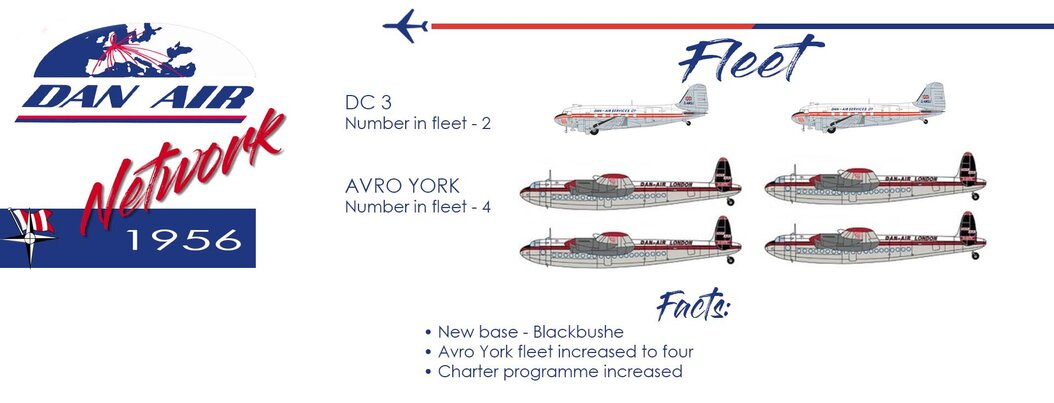
Dan-Air's three Avro Yorks were joined with an extra model being obtained from the RAF. Now four of them would work on passenger charters and cargo flights. More than 350 Hungarian refugees were airlifted to safety in the UK by Dan-Air from Austria where they had fled the Communist regime. Dan-Air commenced its first scheduled service in May of this year, from Blackbushe to Jersey. A our line advertisement in the Daily Herald's classified section was all the airline did to promote the new service.
1956 was a year of expansion for overseas tour organisations. Sir Henry Lunn Limited was offering a wide range of destinations including Spain - Tangiers - Gibraltar for 61 Guineas. Venice and Yugoslavia at 71 Guineas and the Costa Brava at £41 Guineas. Poly Tours on the other hand, were offering much cheaper holidays with Ostend for eight days at just £14 and 10 shilling. Horizon Holidays were, by far, the largest of the Tour Operators desperate to get UK citizens to part with their money and head overseas. Names that became familiar in later years had already started to establish themselves, with Frames, The Swiss Travel Service and Paris Travel Service all heavily advertising.
The state owned carriers, BOAC and BEA were criticised for not performing as well as their American counterparts. Member of Parliament Mr. Orr Ewing said that BOAC employed more staff than any airline in the world, with the exception of Pan Am (16,087 compared with 17,805) and that BEA, with 99 aircraft had 373,000 network miles compared with Pan Am's 826,000. Pan Am had been profitable, whilst BOAC and BEA had made a profit, both carriers had huge operating costs, that the tax-payer were funding. In ten years of operations this was the first year the airline had made any profit. BEA had been operating Airspeed Ambassadors since 1952 and announced that the aircraft had given them substantial advantages over rival carriers. This was reversed when the Viscount entered service in 1953. Several European airlines had ordered the superb Vickers Viscount, Air France, Austrian Airlines were already operating them and they now had the competitive edge. KLM, Alitalia and Lufthansa had all placed significant orders for the aircraft. British European had taken delivery of the first example in March 1953, sixteen would be delivered to them that year. British European then decided that they would retire their Ambassador fleet much earlier than anticipated. One Viscount belonging to BEA was forced to land in France en route from Madrid to London as a result of 'contaminated fuel'. In the ten tears BEA had been operating, fourteen aircraft crashed, eight of which involved the loss of life.
Dan-Air's recent move to Blackbushe had been successful, with an increase in the number of passengers carried. The problems that Dan-Air experienced were the same for all UK independent airlines. The licencing authority, the Air Transport Licencing Board (ATLB) would not relax the regulations allowing the independent carriers access to Heathrow for any scheduled services. Nor would they routinely grant them licences for major trunk routes. One former pilot with British Eagle told us;
'There wasn't a lot of point in applying. When we entered discussions with the ATLB about a possible service from A to B we were told that there wasn't the demand, and that all the services necessary were covered by BEA. If we pointed one out that wasn't, we were then told that there were perfectly good connections between there and Heathrow and the air fares were competitive enough. The idea that an independent airline might actually be as good as them just didn't occur to them. We were told that we didn't have the necessary experience or operational support at the other airport. How an airline was to get that without operating was a mystery. We had started in the same way as our rivals. Operating cargo flights to and from anywhere that would have us. After five years, we got a licence to operate as scheduled service to Belgrade, via Munich using 24 seater Vikings that we had got from BEA. We were not even allowed to pick passengers up in Munich! We got a licence to fly into Gothenburg. Those two flights would not have had BEA quaking in their boots.We didn't make a profit on the schedules until about ten years after starting them.'
The UK Government did however, finally relax rules on inclusive tours. The Ministry of Aviation granted airlines permission to operate a limited programme of a new type of low-fare service that combined air travel and overseas holiday accommodation at a cost substantially below the aggregate of each individual component if purchased separately. This new concept enabled the airline to circumvent regulatory restrictions that prevented private airlines from competing with their state-owned counterparts.
British Eagle did approach Thomas Cook & Son travel agency to offer the former to take on the role of the airline's tour operator. Thomas Cook rejected the offer immediately, and in response British Eagle acquired the Sir Henry Lunn Ltd travel agency chain. This made the airline one of the pioneers of the British package holiday industry, and probably marked the first occasion in the UK where an airline became vertically integrated with its own in-house tour operator. British Eagle then acquired the Polytechnic Touring Association and formed Lunn Poly from the two agencies in the mid-1960s.
Airlines such as Hunting-Clan and Air Charter had established a presence on long-haul flights that had become de-facto third class scheduled services to African cities. These services were so popular that flights were booked up five months in advance. The Government stepped in, requiring these airlines to make additional stops along the way. When newer aircraft entered service, the stops were not necessary. However, the Government insisted they maintain the stops. To add insult to the injury they then insisted that the independents share traffic with BOAC on a 70:30 basis in BOAC's favour. The two airlines joined the Airworks group as did Air Safari who had also been operating into Africa. One other UK carrier, Transair had started life carrying newspapers before having its ten strong DC3 fleet chartered by Horizon Holidays for the fledgling inclusive tour packages. Transair became very profitable and was looking to expand. The lack of available finance saw Transair join the Airwork group of companies,where it became the most profitable airline in the group.
In November of this year, a Dan-Air Avro York became the first aircraft to land at Suez following the crisis at the Egyptian canal.
Skyways flew scheduled services from Stansted to Nicosia via Malta using Avro York aircraft and offering a substantially lower cost than BEA. Others such as Britavia, Morton Airways, Silver City Airways, and BKS were all vying for similar work. Many would be given licences by the Air Ministry to carry troops to British overseas bases. Dan-Air would be given the right to operate services on behalf of British European Airways out of Heathrow. The situation was far from ideal. Ultimately airlines would be forced to either join forces with each other or close down. Dan-Air was in a unique position in that it had not stretched itself financially with huge expansion plans, nor ordered newer and larger aircraft without really needing them. Dan-Air was one of the few airlines that operated in profit. This was all the more impressive when one considers that they were not part of a group of airlines.
1957
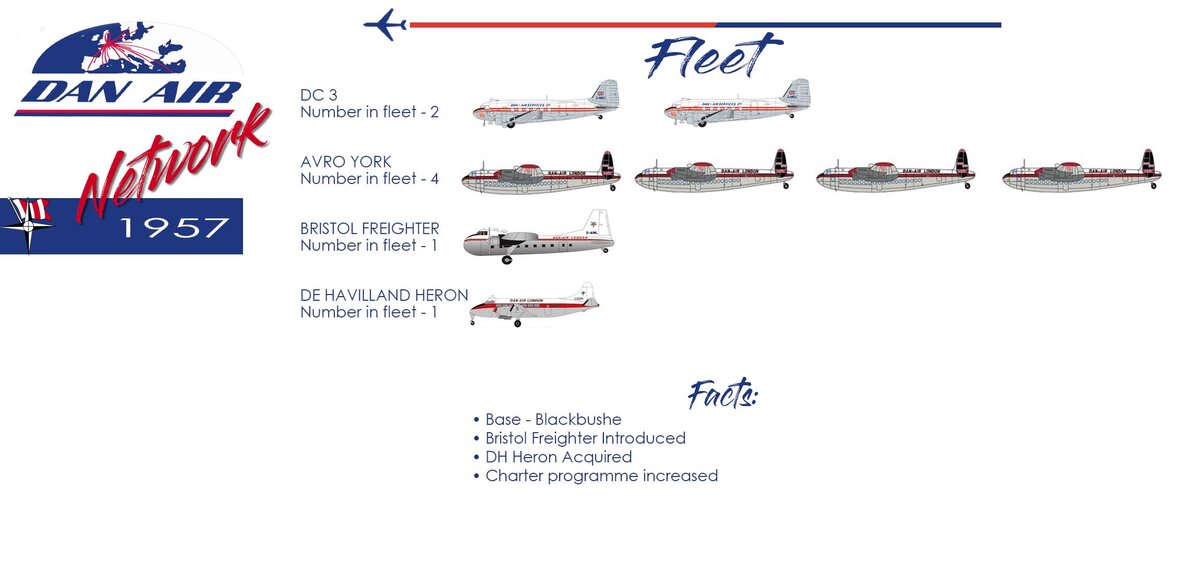
Dan-Air's acquired three additional aircraft in 1957 a De-Havilland Heron a Bristol Freighter and a further Avro York. Behind closed doors, plans were being made to link British cities together. The thinking behind this was that the airline could feed passengers into other airlines' flights to airports overseas. Whilst it was true that British European Airways (BEA) did have most major airports covered with flights from major airports into London, and an extensive network of direct flights to Europe from regional airports, several cities did not have a link at all. Dan-Air believed that they could also provide businessmen with flights that would be speedier than the train. The Heron could land on unpaved runways and carry a dozen passengers. Several long-range cargo flights had been chartered and the Bristol Freighter was ideal for taking large loads over long distances. The Bristol Freighter had a bulbous nose complete with hinged doors under the flight deck. Loads such as cars could be driven directly into its cabin. There would not be the need to worry about passenger appeal on these flights.
The UK Government added Dan-Air to its list of approved carriers this year when they were awarded a contract to fly cargo between the UK and the RAF base at Singapore.
For the second year the scheduled London-Jersey service was in operation. The Saturday morning flights were carried out using DC3 aircraft. To help ensure the success of the Blackbushe-Jersey service Dan-Air continued to place Newspaper Advertisements in the Daily Herald...

It is fair to say that the some of aircraft that carried passengers to new destinations were not without limitations. The Avro Yorks and DC3s were all war time models refitted for passenger use. Looking back Dan-Air did not have a similar image to that of BOAC or BEA, the lack of financial clout did impede the purchase of new aircraft. Four years in business had resulted in steady growth, without compromising the company purse. Other airlines had taken risks in ordering larger, more modern equipment only to find that Tour Operators had chosen other airlines or that proposed scheduled services had not been nearly as profitable as hoped. Skyways, Starways and British Eagle had fared better than most. Some of the aircraft were prone to technical issues. One passenger who booked one of the Horizon charters from this period got in touch to say;
"We had booked to fly to Sardinia from Liverpool with, Starways. The airport was pretty basic, it only had a canteen type cafe. Our flight was due to leave about tea time and we were told to get ready to board it. We sat there for a couple of hours. We didn't know if that was normal or not, as first time flyers. So, eventually we get on this DC3 and it starts up. Then it stopped, my wife was not impressed - she suggested we get off and try and get our money back. Eventually we did get off. Then repeated the whole thing. After about six hours in the terminal we were told to board a coach! So we crawl all the way to Blackbushe. We were ferried through customs and given a cup of tea with some toast. Then we were told that our aircraft was ready for boarding. As we walked toward the Dan-Air plane my wife was concerned that the 'new' aircraft was from Denmark. As we got comfortable in our seats you can image our shock and horror when they said the aircraft had a technical issue! Luckily it only took about half an hour and we could stay on board. We arrived in Sardinia 27 hours later than scheduled.'
The 'can do' attitude of Dan-Air was a notable feature that would stay with the airline, and the public's perception of it for the whole history of the airline. The year 1957 was a difficult one for the UK economy and the airline industry in general. With each new aircraft type or opportunity an airline had to make the decision whether they were up for the challenge or to pack the whole thing in.
1958
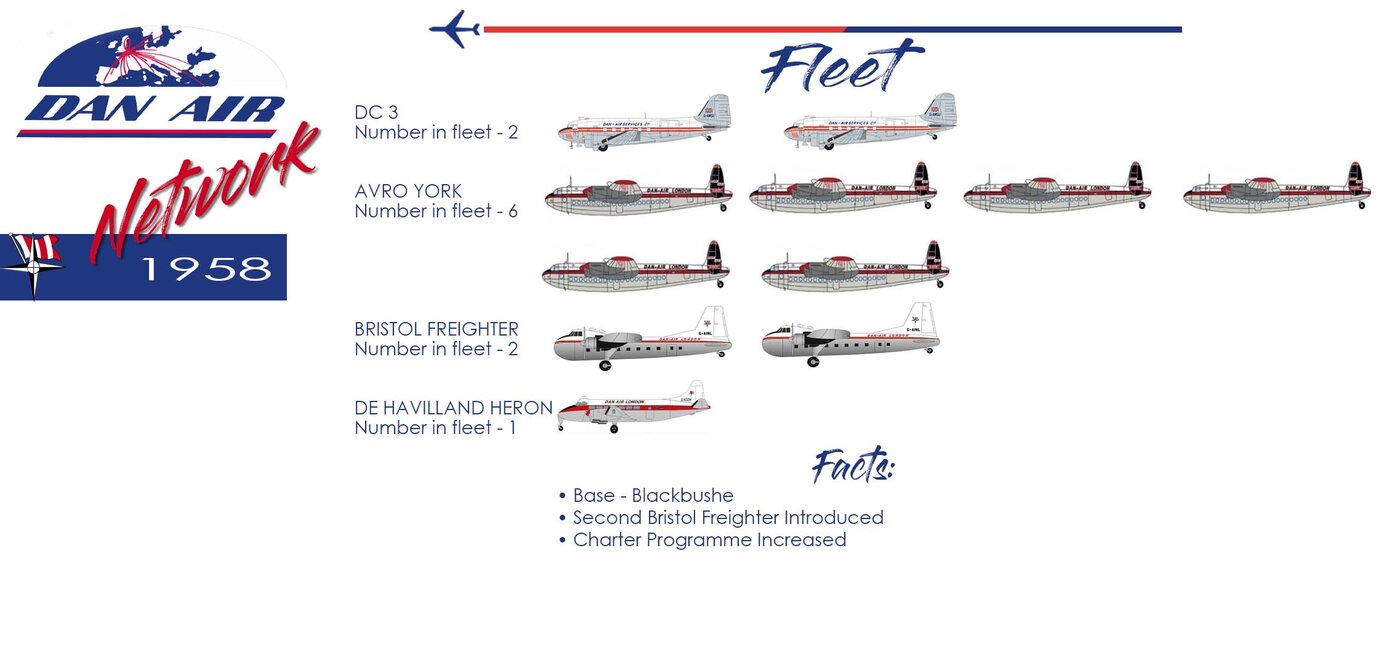
The decision to carry on had been made and new opportunities came Dan-Air's way. The long-haul cargo flights had been a success that necessitated the acquisition of a second Bristol Freighter, which was one of the last built Bristol Freighters. The Ministry of Transport gave approval for a series of charter flights to operate from Manchester in June of this year. Flights would depart to Basle until September 29th, Valencia, Beauvais and Pisa until October 31st. These flights would be flown using the Avro York with the exception of Basle, which would use the DC3.
Charter flights were carried out worldwide. Sadly one of the company Avro York as lost in Malta after overshooting the runway. Dan-Air's first reported SOS occurred in 1958 when a DC carrying 33 passengers from Manchester and London to Ostend suffered an engine fire over the English Channel. Captain Paddy Meed noticed 'veins of black oil on the wing' he radioed a 'mayday' to Air Traffic Control who directed him to return to Manchester. Fir sixty nerve-wracking minutes the engine blazed furiously. The Stewardess, Betty Roberts, aged 21 who had only joined Dan-Air three months prior, managed to keep the passengers spirits up. She joked about the weather in Manchester being worse than Ostend. Meanwhile none of the passengers were aware of the fire. Within a few minutes of him giving the distress signal the radio gave up and the aircraft had to land without ATC assistance. Betty said after the event; 'There was nothing I could do, i had to just spin a line and hoped that it would go down.' As the aircraft with 32 passengers on board, landed at Manchester the aircraft began filling up with misty black smoke which came from the flight deck door, after which, three elderly passengers fainted. After the smooth landing, five fire engines were on hand to deal with the problem.
Manchester was becomming important to Dan-Air with northern travel agents chartering several aircraft for the summer season. The management at the airline knew that to compete with rival airlines they would need to obtain larger, more modern equipment. Salvation came when airlines had started a gradual phase out of their Airspeed Ambassador fleets. Initial talks were held between Butler Air Transport and Shell late this year. The aircraft would be available from November the following year. The aircraft would carry between 55 and 65 passengers and be capable of reaching most of Europe's airports non-stop. The aircraft was pressurised meaning it could fly higher, above most bad weather. The aircraft were also relatively young, having been manufactured in 1953.
Dan-Air's scheduled network grew with an international destination added. The new service would fly between Blackbushe and Basle. Ad hoc charters were also carried out regularly. Italian hoteliers complained bitterly at the UK's Air Transport Licensing Board (ATLB) for rejecting some of the charter flight licences applied for by UK airlines.
1959

The contract to operate from London Heathrow to Glasgow via Manchester on behalf of British European Airways was important to Dan-Air. Although it was a cargo only flight it did show the Air Transport Licencing Board that Dan-Air was a capable airline.
UK Authorities were not alone in making life difficult for independent airlines. Several charter flights to Italy which had been approved by the UK's Air transport Licencing Authority (ATLB) were cancelled. The Italian Government's licencing authority, the Office of Italian Aviation had cancelled the flights, with the local news agency, ANSA claiming it was an attempt to protect their state owned airline, Alitalia. the majority of the flights affected Pisa, with several nearby resorts losing hundreds of valuable holiday-makers. Several airlines including Dan-Air, Hunting Clan, Derby Aviation, British Eagle and Starways were affected. The local Mayor along with several hotel and business owners demonstrated, writing to the Minister to demand that the flights go ahead.
Blackbushe Airport was to close at the end of the year with staff being effectively made redundant from October. The once thriving airport was now looking bleak as carriers had sought new bases. No UK airlines would be given access to Heathrow, especially for charter flights. Dan-Air was based in London and wished to remain so.
Blackbushe had proved not to be adequate for a growing airline. In no small part because the runway passed a major road. The UK Government insisted that all UK airlines wishing to operate in and out of London would have to do so through Gatwick when it opened. However, they said none of BOAC or BEA flights would have to operated from Gatwick when it opened to the public. British European Airways was in a fortunate position at Heathrow where they flew direct to every major European city, including all the capitals. In addition they flew into Heathrow from several UK airports, providing an unequalled network.
Dan-Air had operated the majority of their flights carrying cargo. Charter flight numbers had increased, with the airline's reputation growing, they felt in a strong enough position to apply for a raft of scheduled services. The Air Transport Licencing Board (ATLB) granted Dan-Air licences in December to fly five scheduled services. Bristol - Gatwick, Liverpool, The Isle of Man, Basle and Deauville. Approval was granted by the ATLB and the flights would commence in May next year. The international services would have to be ratified by the French and Swiss authorities. The Bristol-Isle Of Man flights would be operated by Bristol Freighters which the airport was quick to point out, of special interest as the local airport would be served by a locally built aircraft. The Bristol Freighter had new been re-names the Bristol Wayfarer as it would now be configured to carry passengers. DC3 Dakotas would fly between Bristol and the Isle of Man.
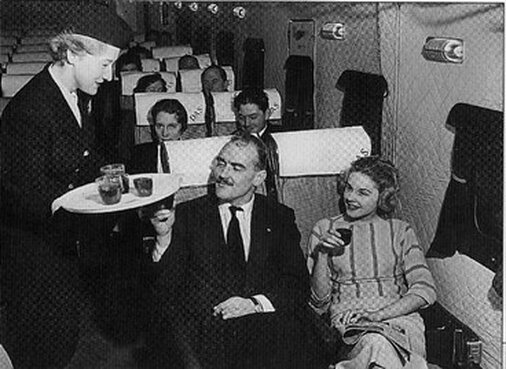
Interior of a Wayfarer.
The Ambassador joined the fleet in November, it would have to be refitted with Dan-Air seating and repainted in company colours before entering service for the 1960 season. This was carried out at Lasham. The ambassador had carried 47 passengers in its previous life, in what was considered a 'quiet cabin for a piston engine aircraft' Dan-Air would need them to carry up to 55. This was straight forward as the manufacturers had invested heavily in ensuring the comfort and space of its passengers. The Ambassador contained power points in its galley that enabled cooked food to be brought aboard and kept at the correct temperature, courtesy of insulation with glass and cotton wool. This was not the usual standard for Dan-Air passengers who would be offered tea and coffee with sandwiches and salads. On ad hoc charters where hot catering was required the airline could oblige. The Ambassador could fly at 20,000 feet, avoiding most of the bad weather.
Other airlines had begun to equip their own fleets with more up to date models. Derby Airways had ordered Argonauts and British Eagle the Viscount. Competition was intense and Dan-Air would need a more visible presence.
DISCUSS THIS SUBJECT
0
reviews

